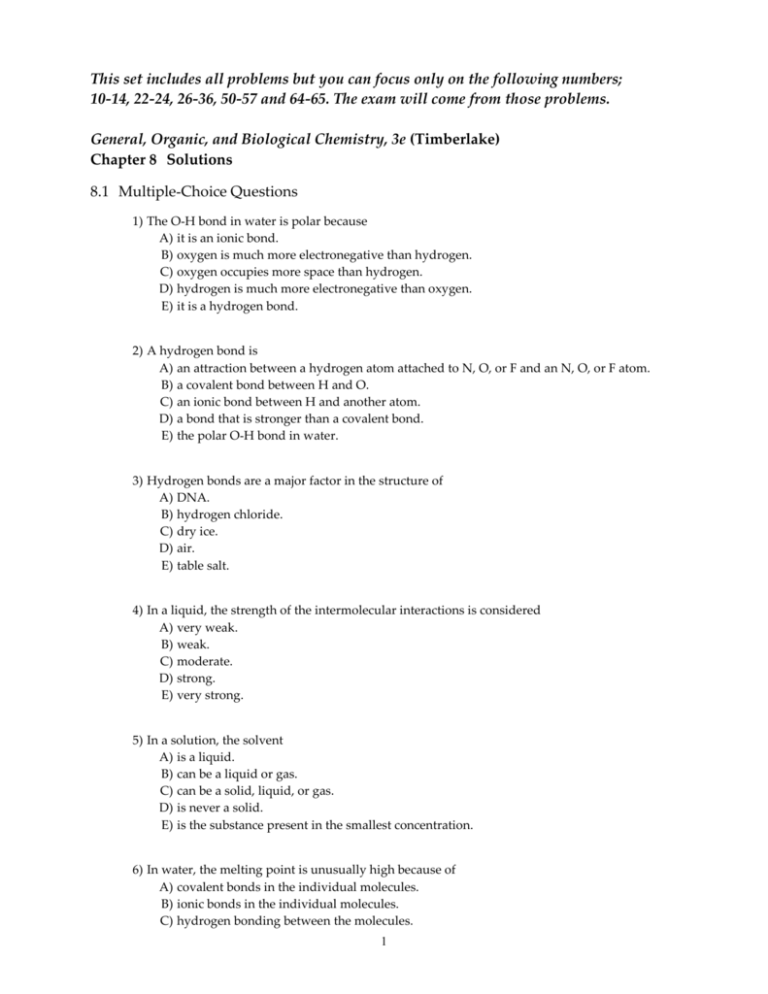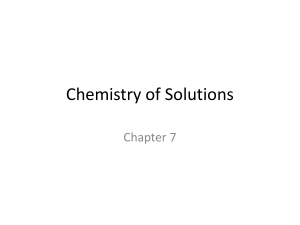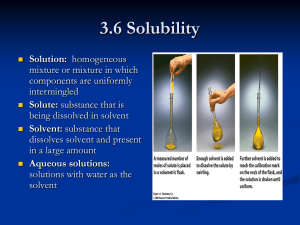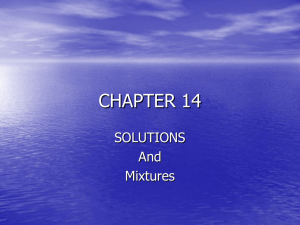Testbank to accompany GOB Chemistry, 3e
advertisement

This set includes all problems but you can focus only on the following numbers; 10-14, 22-24, 26-36, 50-57 and 64-65. The exam will come from those problems. General, Organic, and Biological Chemistry, 3e (Timberlake) Chapter 8 Solutions 8.1 Multiple-Choice Questions 1) The O-H bond in water is polar because A) it is an ionic bond. B) oxygen is much more electronegative than hydrogen. C) oxygen occupies more space than hydrogen. D) hydrogen is much more electronegative than oxygen. E) it is a hydrogen bond. 2) A hydrogen bond is A) an attraction between a hydrogen atom attached to N, O, or F and an N, O, or F atom. B) a covalent bond between H and O. C) an ionic bond between H and another atom. D) a bond that is stronger than a covalent bond. E) the polar O-H bond in water. 3) Hydrogen bonds are a major factor in the structure of A) DNA. B) hydrogen chloride. C) dry ice. D) air. E) table salt. 4) In a liquid, the strength of the intermolecular interactions is considered A) very weak. B) weak. C) moderate. D) strong. E) very strong. 5) In a solution, the solvent A) is a liquid. B) can be a liquid or gas. C) can be a solid, liquid, or gas. D) is never a solid. E) is the substance present in the smallest concentration. 6) In water, the melting point is unusually high because of A) covalent bonds in the individual molecules. B) ionic bonds in the individual molecules. C) hydrogen bonding between the molecules. 1 D) dispersion forces between the molecules. E) the heat content of the hydrogen-oxygen bonds. 7) Which of the following molecules can form hydrogen bonds? A) CH4 B) NaH C) NH3 D) BH3 E) HI 8) Water has a boiling point of 100 °C, and alcohol has a boiling point of 78 °C, even though water is a smaller molecule. This large difference in boiling point is due to A) weak dispersion forces in the alcohol molecules. B) ionic bonds between the water molecules. C) covalent bonds in the ethanol molecules. D) stronger hydrogen bonds between the water molecules. E) stronger hydrogen bonds between the alcohol molecules. 9) A solution is prepared by dissolving 2 g of KCl in 100 g of H2O. In this solution, H2O is the A) B) C) D) E) solute. solvent. solution. solid. ionic compound. 10) Oil does not dissolve in water because A) oil is polar. B) oil is nonpolar. C) water is nonpolar. D) water is saturated. E) oil is hydrated. 11) When KCl dissolves in water A) the Cl- ions are attracted to dissolved K+ ions. B) the Cl- ions are attracted to the partially negative oxygen atoms of the water molecule. C) the K+ ions are attracted to Cl- ions on the KCl crystal. D) the K+ ions are attracted to the partially negative oxygen atoms of the water molecule. E) the K+ ions are attracted to the partially positive hydrogen atoms of the water molecule. 2 12) Water is a polar solvent and hexane (C6H14) is a nonpolar solvent. Which of the following correctly describes the solubility of the solute? A) mineral oil, soluble in water B) CaCl2, soluble in hexane C) HaHCO3, soluble in water D) CCl4, soluble in water E) octane, soluble in water 13) In water, a substance that ionizes completely in solution is called a A) weak electrolyte. B) nonelectrolyte. C) semiconductor. D) nonconductor. E) strong electrolyte. 14) In water, a substance that partially ionizes in solution is called a A) weak electrolyte. B) nonelectrolyte. C) semiconductor. D) nonconductor. E) strong electrolyte. 15) An equivalent is A) the amount of ion that has a 1+ charge. B) the amount of ion that has a 1- charge. C) the amount of ion that carries 1 mole of electrical charge. D) 1 mole of any ion. E) 1 mole of an ionic compound. 16) How many equivalents are present in 5.0 g of Al3+? A) 15 Eq B) 0.56 Eq C) 0.19 Eq D) 0.37 Eq E) 3 Eq 17) How many equivalents are present in 5.0 moles of Al3+? A) 15 Eq B) 1.3 Eq C) 5.0 Eq D) 0.67 Eq E) 3.0 Eq 3 18) An intravenous replacement solution contains 4.0 mEq/L of Ca2+ ions. How many grams of Ca2+ are in 3.0 L of the solution? A) B) C) D) E) 0.24 g 0.80 g 0.40 g 240 g 4.0 g 19) When some of the sugar added to iced tea remains undissolved at the bottom of the glass, the solution is A) dilute. B) polar. C) nonpolar. D) saturated. E) unsaturated. 20) The solubility of KI is 50 g in 100 g of H2O at 20 °C. If 110 grams of KI are added to 200 grams of H2O, A) B) C) D) E) all of the KI will dissolve. the solution will freeze. the solution will start boiling. a saturated solution will form. the solution will be unsaturated. 21) An increase in the temperature of a solution usually A) increases the boiling point. B) increases the solubility of a gas in the solution. C) increases the solubility of a solid solute in the solution. D) decreases the solubility of a solid solute in the solution. E) decreases the solubility of a liquid solute in the solution. 22) Which one of the following compounds will NOT be soluble in water? A) NaOH B) PbS C) K2SO4 D) LiNO3 E) MgCl2 23) Which one of the following compounds will NOT be soluble in water? A) LiOH B) K2S C) BaSO4 D) NaNO3 E) MgCl2 4 24) Which one of the following compounds will be soluble in water? A) AgCl B) Cu(OH)2 C) LiCl D) CaSO4 E) PbCO3 25) Which one of the following compounds will be soluble in water? A) AgBr B) Cu(OH)2 C) NaH4Cl D) CaCO3 E) PbS 26) When solutions of KCl and Pb(NO3)2 are mixed, a precipitate forms. Which of the following is the balanced equation for the double replacement reaction that occurs? A) KCl(aq) + Pb(NO3)2 (aq) → KNO3 (aq) + PbCl2 (s) B) KNO3 (aq) + PbCl2 (s) → KCl(aq) + Pb(NO3)2 (aq) C) K+ (aq) + NO -(aq) → KNO (aq) 3 3 D) 2KCl (aq) + Pb(NO3)2 (aq) → 2 KNO3 (aq) + PbCl2 (s) E) KCl(aq) + Pb(NO3)2 (aq) → KNO3 (aq) + PbCl(s) 27) When solutions of NaCl and AgNO3 are mixed, A) a precipitate of AgCl forms. B) a precipitate of NaNO3 forms. C) no precipitate forms. D) precipitate of NaNO3 and AgCl form. E) a precipitate of AgCl2 forms. 28) The mass/mass percent concentration refers to A) grams of solute in 1 kg of solvent. B) grams of solute in 1 kg of solution. C) grams of solute in 100 g of solvent. D) grams of solute in 100 g of solution. E) grams of solvent in 100 g of solution. 29) The mass/volume percent concentration refers to A) grams of solute in 1 L of solvent. B) grams of solute in 1 L of solution. C) grams of solute in 100 mL of solvent. D) grams of solute in 100 mL of solution. E) grams of solvent in 100 mL of solution. 5 30) What is the concentration, in m/m%, of a solution prepared from 50.0 g NaCl and 150.0 g of water? A) 0.250% B) 33.3% C) 40.0% D) 25.0% E) 3.00% 31) Rubbing alcohol is 70.% isopropyl alcohol by volume. How many mL of isopropyl alcohol are in a 1 pint (473 mL) container? A) 70. mL B) 0.15 mL C) 680 mL D) 470 mL E) 330 mL 32) What is the concentration, in m/v%, of a solution prepared from 50. g NaCl and 2.5 L of water? A) 5.0% B) 2.0% C) 0.020% D) 0.050% E) 20.% 33) How many grams of glucose are needed to prepare 400. mL of a 2.0%(m/v) glucose solution? A) 800. g B) 0.0050 g C) 8.0 g D) 2.0 g E) 200. g 34) A patient needs to receive 85 grams of glucose every 12 hours. What volume of a 5.0%(m/v) glucose solution needs to be administered to the patient each 12 hours? A) 1700 mL B) 60 mL C) 6000 mL D) 17 mL E) 204 mL 35) What volume (mL) of a 15% (m/v) NaOH solution contains 120 g NaOH? A) 18 mL B) 0.13 mL C) 13 mL D) 120 mL E) 8.0 x 102 mL 6 36) How many milliliters of a 25% (m/v) NaOH solution would contain 75 g of NaOH? A) 25 mL B) 75 mL C) 33 mL D) 19 mL E) 3.0 x 102 mL 37) A(n) __________ is a type of colloid in which a liquid is dispersed in another liquid or a solid. A) suspension B) aerosol C) foam D) sol E) emulsion 38) A homogeneous mixture that does not settle out upon standing is A) an element. B) a colloid. C) a suspension. D) homogeneous. E) hydrated. 39) In the process known as osmosis, __________ moves through a semipermeable membrane into an area of __________ concentration. A) solute; lower solute B) solute; higher solute C) solvent; lower solute D) solvent; lower solvent E) solvent; higher solvent For the question(s) that follow, consider a 4% starch solution and a 10% starch solution separated by a semipermeable membrane. 40) Which starch solution will decrease in volume as osmosis occurs? A) 4% B) 10% C) Neither exerts osmotic pressure. D) They exert equal osmotic pressures. E) They exert opposite osmotic pressures. 41) The process that occurs in this system is A) filtration. B) hydration. C) neutralization. D) dialysis. E) osmosis. 7 42) Which of the following also occurs in this system? A) Water flows equally in both directions. B) There is a net flow of water from the 4% starch solution into the 10% starch solution. C) There is a net flow of water from the 10% starch solution into the 4% starch solution. D) Water does not cross the membrane at all. E) Starch moves out of the 10% starch solution into the 4% starch solution. 43) A solution with the same osmotic pressure as the blood is A) isotonic to the blood. B) hypotonic to the blood. C) hypertonic to the blood. D) nontonic to the blood. E) molar to the blood. 44) A solution that has an osmotic pressure less than that of red blood cells is called A) saturated. B) hypertonic. C) isotonic. D) hypotonic. E) unsaturated. 45) A red blood cell will undergo crenation in A) water. B) 0.5% NaCl. C) 3% glucose. D) 5% glucose. E) 7% NaCl. 46) Which solution is isotonic to a red blood cell? A) water B) 0.5% NaCl C) 2% glucose D) 0.9% NaCl E) 10% glucose 47) A red blood cell will undergo hemolysis in A) water. B) 0.9% NaCl. C) 5% glucose. D) 5% NaCl. E) 10% glucose. 8 48) The process by which a semipermeable membrane allows water molecules, small molecules, and ions to pass through while retaining large particles is called A) osmotic pressure. B) dialysis. C) solvation. D) dilution. E) hydration. 49) An aqueous mixture containing starch (a colloid), NaCl, glucose, and albumin (a colloid) is placed in a dialyzing bag and immersed in distilled water. Which of the following correctly describes the location of the indicated substance after dialysis? A) albumin, inside B) starch outside C) albumin inside and outside D) water inside only E) starch inside and outside 50) What is the molarity of a solution that contains 17 g of NH3 in 0.50 L of solution? A) B) C) D) E) 34 M 2.0 M 0.50 M 0.029 M 1.0 M 51) What is the molarity of a solution that contains 3.25 moles of NaNO3 in 250. mL of solution? A) B) C) D) E) 3.25 M 6.50 M 0.0130 M 13.0 M 2.60 M 52) When 200. mL of water are added to 100. mL of 12% KCl solution the final concentration of KCl is (Assume the volumes add.) A) 12%. B) 4.0%. C) 36%. D) 6.0%. E) 8.0%. 53) The molarity (M) of a solution refers to A) moles of solute/L of solution. B) moles of solute/L of solvent. C) moles of solute/100 mL of solution. D) grams of solute/100 mL of solution. E) grams of solute/L of solution. 9 54) What is the molarity of a solution containing 5.0 moles of KCl in 2.0 L of solution? A) 2.5 M B) 1.0 M C) 5.0 M D) 10. M E) 2.0 M 55) What is the molarity of a solution which contains 58.5 g of sodium chloride dissolved in 0.500 L of solution? A) 0.500 M B) 1.00 M C) 1.50 M D) 2.00 M E) 4.00 M 56) How many moles of CaCl2 are in 250 mL of a 3.0 M of CaCl2 solution? A) B) C) D) E) 750 moles 1.3 moles 83 moles 0.75 mole 3.0 moles 57) What volume of a 1.5 M KOH solution is needed to provide 3.0 moles of KOH? A) 3.0 L B) 0.50 L C) 2.0 L D) 4.5 L E) 0.22 L 58) During the process of diluting a solution to a lower concentration, A) the amount of solute does not change. B) the amount of solvent does not change. C) there is more solute in the concentrated solution. D) the volume of the solution does not change. E) water is removed from the concentrated solution. 59) According to Henry's law, the solubility of a gas in a liquid A) decreases as the gas pressure above the liquid increases. B) increases as the gas pressure above the liquid increases. C) remains the same as the temperature increases. D) depends on the liquid polarity. E) depends on the liquid density. 10 60) What is the molarity of a KCl solution made by diluting 75.0 mL of a 0.200 M solution to a final volume of 100. mL? A) 0.267 M B) 0.150 M C) 0.200 M D) 6.67 M E) 0.100 M 61) What volume of 2.5% (m/v) KOH can be prepared from 125 mL of a 5.0% KOH solution? A) 0.0040 mL B) 63 mL C) 0.10 mL D) 125 mL E) 250 mL 62) What volume of 0.10 M NaOH can be prepared from 250. mL of 0.30 M NaOH? A) 0.075 L B) 0.25 L C) 0.75 L D) 0.083 L E) 750 L 63) What volume of a 2.00 M KCl solution is required to prepare 500. mL of a 0.100 M KCl solution? A) 0.0400 mL B) 25.0 mL C) 2.00 mL D) 1.00 x mL E) 5.00 x mL 64) What is the new mass/volume (m/v)% of a KOH solution that is prepared by diluting 110 mL of a 6% (m/v) KOH solution to 330 mL? A) 2% B) 1% C) 6% D) 12% E) 18% 65) Use the reaction: 2AgNO3(aq) + H2SO4(aq) → Ag2SO4(s) + 2H2O(l) What volume of 0.123 M AgNO3(aq) is needed to form 0.657 g of Ag2SO4(s)? A) B) C) D) E) 34.2 L 17.1 mL 34.2 mL 10.7 mL 53.4 mL 11 8.2 Bimodal Questions 1) Acetic acid can be classified as a __________. A) gas B) solid C) weak electrolyte D) strong electrolyte E) ionic compound 2) NaCl can be classified as a __________. A) gas B) liquid C) weak electrolyte D) strong electrolyte E) nonelectrolyte 3) Methanol, CH3OH, can be classified as a __________. A) B) C) D) E) gas solid weak electrolyte strong electrolyte nonelectrolyte 4) Using a kidney machine to remove waste products from the blood is known as __________. A) osmosis B) osmolysis C) autolysis D) hemolysis E) hemodialysis 5) A mixture in which one component settles is called a(n) __________. A) solution B) colloid C) suspension D) electrolyte E) nonelectrolyte 6) The molarity of a solution of 5.0 g of KCl in 100. mL of solution is __________. A) 0.038 M B) 0.067 M C) 0.67 M D) 0.13 M E) 1.3 M 12 7) If 100. mL of water is added to 25 mL of 5.0 M NaCl, the final concentration is __________. A) 25 M B) 1.0 M C) 5.0 M D) 2.0 M E) 1.3 M Answer: B 8.3 Short Answer Questions 1) Is barium sulfate, BaSO4, soluble or insoluble in water? Answer: insoluble 2) In the following equation, __________ will precipitate out of water solution. NaCl + AgNO3 → AgCl + NaNO3 3) In the following equation, __________ will precipitate from solution. BaCl2 + H2SO4 → BaSO4 + 2HCl 4) The number of moles of a compound dissolved in one liter of a solution is called the __________. 5) A substance that carries an electric current when dissolved in water is called a(n) __________. 6) A substance that produces only a small number of ions in solution is known as a __________ electrolyte. 7) A solution of sodium carbonate, Na2CO3, that has a molarity of 0.0100 M contains __________ equivalents of carbonate per liter of the solution. 8) A solution of sodium carbonate, Na2CO3, that has a molarity of 0.0100 M contains __________ equivalents of sodium ions per liter of the solution. 9) Substances whose particles in solution scatter light and pass through filters but cannot pass through semipermeable membranes are called __________. 13 8.4 Matching Questions Identify the term defined in each description. 1) a solution that contains the highest amount of solute that dissolves at a given temperature A) hydration B) saturated 2) the major attraction between water molecules 3) the association of several water molecules with ions produced in a solution C) unsaturated D) hydrogen bonding E) hypertonic F) hypotonic 4) a solution in which more solute can be dissolved 5) a solution that has a higher osmotic pressure than the red blood cells of the body Match the type of mixture with the appropriate characteristics. 6) a mixture of sodium chloride in water 7) a mixture whose particles settle on standing 8) a homogeneous mixture in which suspended particles cannot pass through a semipermeable membrane A) colloid B) suspension C) solution 9) a mixture whose particles cannot be separated by filters or semipermeable membranes 10) a mixture whose particles can be separated by filters 14 Compare the osmotic pressure of these solutions to the osmotic pressure of red blood cells. 11) water A) hypotonic 12) 0.5% NaCl B) isotonic 13) 7% glucose C) hypertonic 14) 5% glucose 15) 0.9% NaCl Indicate whether each of the following compounds dissolves in water to give ions, molecules, or both. 16) NaCl, a strong electrolyte A) both 17) HI, a weak electrolyte B) ions 18) CH3CH3OH, a nonelectrolyte 19) KNO3, a strong electrolyte C) molecules 20) glucose, a nonelectrolyte 21) H2CO3, a weak electrolyte 15







